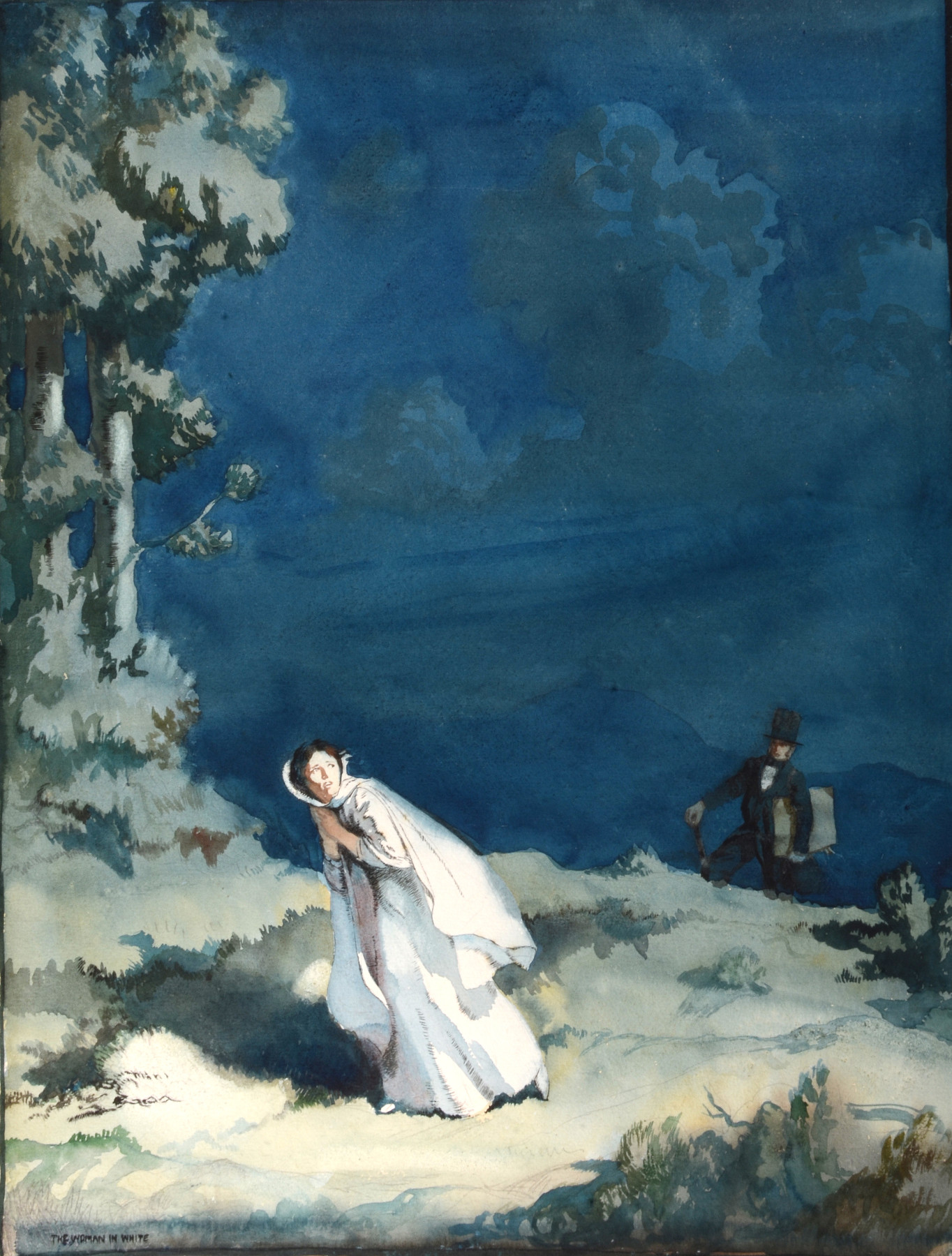
(click image to enlarge)
William Orpen’s The Woman in White was inspired by Wilkie Collins’s ground-breaking ‘sensation novel’ of the same name, which was first published, in serial form in All the Year Round, in 1859-60. However, it was more likely intended as an exhibition watercolour than as an illustration for a specific edition of the novel, and was shown at both the New English Art Club, in Winter 1903, as No 9, and the sixth of the Goupil Gallery’s ‘Salon Series’, in November-December 1911 (where it was priced at £31).
The watercolour almost certainly depicts the nocturnal encounter between the upright young drawing-master, Walter Hartright, and 36 the ‘woman in white’, Anne Catherick (in ‘The First Epoch’, part one, chapter IV). Anne is the illegitimate half-sister of the novel’s heroine, Laura Fairlie, and a victim of Laura’s fiancé and later husband, the villainous Sir Percival Glyde. Though the encounter takes place on Hampstead Heath, Orpen’s interpretation of the setting is wild and desolate, as if suggesting Anne’s vulnerable state and agitated manner, following her escape from the asylum in which Glyde has had her incarcerated.
Collins’s novel had an impact on its initial publication in 1859-60 that was immediately reflected in the visual arts. For instance, when James McNeill Whistler’s painting, Symphony in White No 1: The White Girl, appeared at the Berners Street Gallery in 1862, it was under the title, The Woman in White. Perhaps inevitably, F G Stephens, the critic of The Athenaeum, took this to indicate that it was illustrative of the novel (28 June 1862). As a result, Whistler was forced to write to the magazine, stating that the title was chosen by the gallery, that he had not read the novel and that the ‘painting simply represents a girl dressed in white standing in front of a white curtain’ (5 July). However, Frederick Buckstone, the gallery’s secretary, subsequently wrote to The Athenaeum to say that ‘Mr Whistler was aware of ... and pleased with the name’ (19 July).
A decade later, in 1871, another arresting image returned the novel to the public’s conscience, though this time with a more definite intention. Frederick Walker designed what was arguably ‘the first high-art poster the world ever knew’ (The Athenaeum, 27 October 1894) to advertise Wilkie Collins’s own dramatisation of his novel, produced at the Olympic Theatre. It shows the back view of Anne Catherick, filling almost all of the picture space, exiting through a doorway and into the night.
When Orpen decided to respond to The Woman in White, early in the twentieth century, he may have done so for at least two reasons. Firstly, the trope – of a female figure dressed in white – offered formal and atmospheric possibilities. Secondly, the narrative situation – of an awkward, unequal encounter between a man and a woman – chimed with other literary subjects of interest.
Orpen produced a number of paintings of women dressed in white – sometimes modelled by his wife, Grace – that in all likelihood signalled his approval of the purely painterly qualities of Whistler in particular and of the synthesis of Aestheticism and Impressionism that he had helped to engender. One group of these paintings explores a figure on a beach or cliff, standing in a fresh breeze and sparkling light, and backed by scudding clouds; another, by contrast, has the figure seated at a window, either in reverie or looking out at a deep blue evening sky. To a degree, the present watercolour combines these two modes, the figure standing and on the move but set against the night and illuminated by the unseen moon.
While dedicated to the idea of pure painting, Orpen retained his early interest in literary and theatrical subjects. For instance, in 1901, around the time that The Woman in White is likely to have been painted, he produced several works in response to Max Beerhohm’s The Happy Hypocrite. This ‘Fairy Tale for Tired Men’, set during the Regency age, was first published as a story in 1897, and then dramatised for a production at the Royalty Theatre in 1900, which Orpen is likely to have seen. The artist chose to focus on the initial encounter between the title character, Lord George Hell, and the dancer, Jenny Mere, when he seems at his most licentious and she at her most innocent – rather than on his reform, which proves to be the result of his devoted love for her. This encounter is presented visually as a melodramatic contrast between the erect, dark, brooding presence of Hell and the submissive, even cowering, white-dressed form of Jenny. Though Hell is a more troubling figure than Collins’s Hartrick, they share elements of their appearance – including top hats and canes – and comparison with The Woman in White is clear.